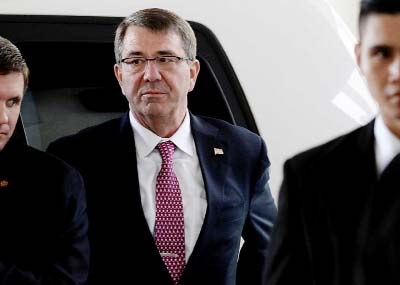
AFP, Simi Valley :
US Defence Secretary Ashton Carter on Saturday warned that land reclamation efforts and a military buildup in the South China Sea could lead to conflict between nations in the region.
Speaking at a defense forum at the Ronald Reagan Presidential Library in California, the Pentagon chief also said America was adapting its military posture to counter increased Russian “aggression.”
Appearing on the final leg of an eight-day trip that included meetings with defense ministers from several nations in the Asia-Pacific region, Carter said his concerns about the frantic pace of land reclamation in the South China Sea were broadly shared.
“The United States joins virtually everyone else in the region in being deeply concerned about the pace and scope of land reclamation in the South China Sea,” Carter told an audience of senior defense figures.
Carter added he was worried about “the prospect of further militarization, as well as the potential for these activities to increase the risk of miscalculation or conflict among claimant states.”
The Reagan National Defense Forum is an annual event that sees dozens of America’s top defense figures — including politicians from both political parties — discuss America’s defense policies.
Carter used his platform to take a swipe at recent Russian military moves.
“At sea, in the air, in space and in cyberspace, Russian actors have engaged in challenging activities,” he said.
“And, most disturbing, Moscow’s nuclear saber-rattling raises questions about Russian leaders’ commitment to strategic stability, their respect for norms against the use of nuclear weapons and whether they respect the profound caution nuclear-age leaders showed with regard to the brandishing of nuclear weapons.”
In an echo of some of Reagan’s own attempts to use technology to counter a Soviet nuclear threat, Carter talked up some of America’s new high-tech weaponry, including an electromagnetic railgun that can fire projectiles at an astonishing 4,500 miles (7,250 kilometers) per hour.
He added that the United States was modernizing its nuclear arsenal, investing in new technologies such as drones and a new long-range bomber, as well as lasers and new systems for electronic warfare.
The defense chief hinted at additional new weapons that would be “surprising ones I really can’t describe here.”
Additionally, “we’re updating and advancing our operational plans for deterrence and defense given Russia’s changed behavior,” Carter said.
Russia annexed Crimea in 2014 and has been supporting a pro-Moscow separatist conflict in eastern Ukraine.
Russian jets also started bombing Syria on September 30.
Moscow says the campaign aims to counter the Islamic State militant group but the West says Moscow is trying to support President Bashar al-Assad’s regime.
Carter’s trip was dominated by questions over China’s continued land reclamation efforts and military buildup in the South China Sea.
US Defence Secretary Ashton Carter on Saturday warned that land reclamation efforts and a military buildup in the South China Sea could lead to conflict between nations in the region.
Speaking at a defense forum at the Ronald Reagan Presidential Library in California, the Pentagon chief also said America was adapting its military posture to counter increased Russian “aggression.”
Appearing on the final leg of an eight-day trip that included meetings with defense ministers from several nations in the Asia-Pacific region, Carter said his concerns about the frantic pace of land reclamation in the South China Sea were broadly shared.
“The United States joins virtually everyone else in the region in being deeply concerned about the pace and scope of land reclamation in the South China Sea,” Carter told an audience of senior defense figures.
Carter added he was worried about “the prospect of further militarization, as well as the potential for these activities to increase the risk of miscalculation or conflict among claimant states.”
The Reagan National Defense Forum is an annual event that sees dozens of America’s top defense figures — including politicians from both political parties — discuss America’s defense policies.
Carter used his platform to take a swipe at recent Russian military moves.
“At sea, in the air, in space and in cyberspace, Russian actors have engaged in challenging activities,” he said.
“And, most disturbing, Moscow’s nuclear saber-rattling raises questions about Russian leaders’ commitment to strategic stability, their respect for norms against the use of nuclear weapons and whether they respect the profound caution nuclear-age leaders showed with regard to the brandishing of nuclear weapons.”
In an echo of some of Reagan’s own attempts to use technology to counter a Soviet nuclear threat, Carter talked up some of America’s new high-tech weaponry, including an electromagnetic railgun that can fire projectiles at an astonishing 4,500 miles (7,250 kilometers) per hour.
He added that the United States was modernizing its nuclear arsenal, investing in new technologies such as drones and a new long-range bomber, as well as lasers and new systems for electronic warfare.
The defense chief hinted at additional new weapons that would be “surprising ones I really can’t describe here.”
Additionally, “we’re updating and advancing our operational plans for deterrence and defense given Russia’s changed behavior,” Carter said.
Russia annexed Crimea in 2014 and has been supporting a pro-Moscow separatist conflict in eastern Ukraine.
Russian jets also started bombing Syria on September 30.
Moscow says the campaign aims to counter the Islamic State militant group but the West says Moscow is trying to support President Bashar al-Assad’s regime.
Carter’s trip was dominated by questions over China’s continued land reclamation efforts and military buildup in the South China Sea.

